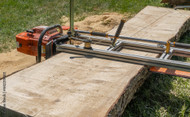If you live in a more rural area and either own land or have friends that do, this is a great source for you. Many woodworkers harvest their own trees for their projects in a respectful and sustainable manner that improves the forest where they live. However, this source can either be the most eco-friendly option on this list or the least depending on your knowledge and practices. Legality is the first thing you need to consider before harvesting trees yourself. The best place to harvest trees is from your own property, or the property of someone who has given you permission to do so. Quite often, there are sick or dying trees in the forest. Removing them allows younger, healthy trees to have more light, water, and nutrients. With some ecological study, walks in the forest, and chats with local experts, you can learn to identify which trees are best for removal. It is very important to never harvest a tree that is too large for your skill level, or one that may be habitat for local wildlife. When in doubt, stick with trees that fall over in storms. A good rule of thumb for determining when a tree died is to look at the twigs. A good candidate will have either leaves, flowers, fruit or buds still visible (if the twigs are too deteriorated to tell, the wood is likely too rotten to use). If a tree has dead flowers still attached, it likely fell last spring; leaves and/or fruit then it fell between summer and fall; and if the twigs have buds only, then it likely fell in winter. If you are a green woodworker, this is especially important because you will want to harvest the freshest trees for your projects.
There are many other woodworking materials that can also be sourced sustainably, such as leather, hardware, paints,and finishes. If you are unsure about a supplier’s sustainability policy, try reaching out to them! I have had many wonderful conversations with people that I buy my materials from and am often pleasantly surprised by how thoughtful their answers are. Woodworking projects, like any handmade item, tell a story. Being connected to the source of your materials enriches that story andcan ultimately deepen your connection to the craft.



